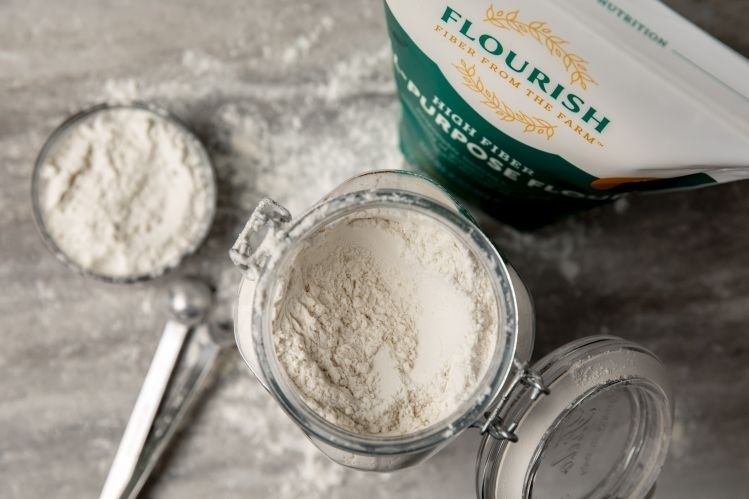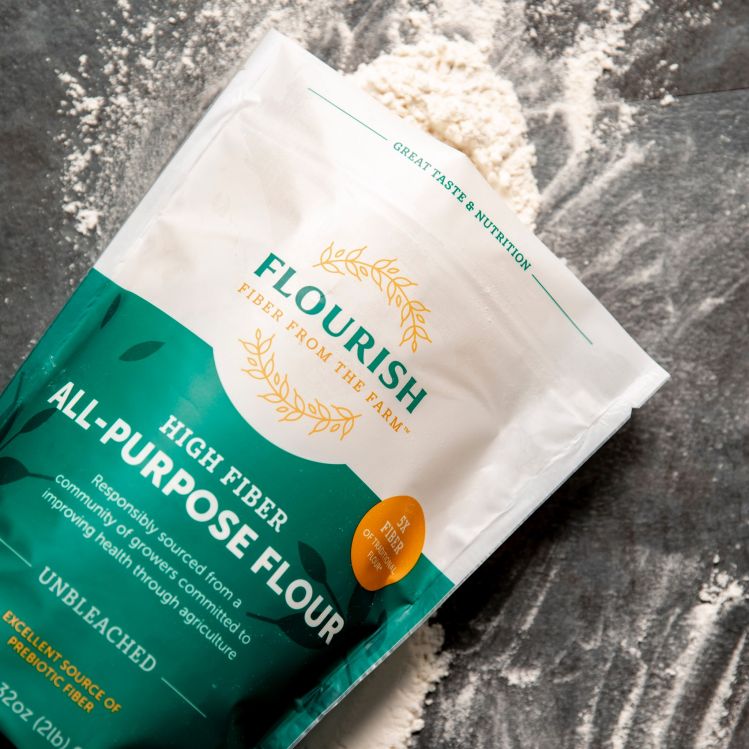Flourish flour has 5x the fiber, but ‘looks, tastes and bakes like all-purpose flour,’ claims Bay State Milling

Unlike whole wheat flour, which contains all the components of the kernel (the germ, the starchy endosperm, and the fibrous bran layer), Flourish is like regular refined all-purpose flour in that it’s made from the endosperm, with a fine pale texture and no grainy bits that can put some consumers off wholewheat flour.
While it doesn’t contain wheat bran, Flourish is nevertheless high in fiber as it's made from a non-GMO, high-amylose variety of wheat with an endosperm very high in resistant starch, a dietary fiber which resists digestion in the small intestine and reaches the large intestine, where it’s fermented, potentially conferring a variety of health benefits.
To put this into perspective, most wheat starch contains around 25% amylose, a resistant starch, and 75% amylopectin, an easy digestible source of starch. The starch in Flourish “flips this ratio on its head” and contains around 75% amylose, marketing executive Jillian Wishman told FoodNavigator-USA.
“Unlike the fiber in wheat bran, which many people associate with roughage and regularity, things that people don’t love to talk about, the fiber in Flourish, resistant starch, is a prebiotic fiber, which feeds the good bacteria in your gut, and that can also have immune health benefits."*
'You don’t have to compromise anymore'
Bay State CEO Pete Levangie added: “We’re big proponents of whole grains and whole wheat, but we've learned in some ways painfully, that one of the trade offs there, is that it can be hard to bake with and some consumers struggle with the bitter taste. This is all about another path to bring nutrient dense flour to the marketplace.
“Flourish absorbs more water [than regular all-purpose wheat flour] but it has a freshness in certain applications that is just fabulous.”
Wishman added: “People associate health benefits with whole wheat flour, but what is has in nutrition it can lack in taste and functionality. Traditional refined flour has the taste and functionality, but it has been villainized as lacking in nutrition.
“Flourish delivers a delicious white flour that tastes and bakes like all-purpose flour but has the nutrition people are looking for, so the biggest message we’re putting forward is that you don’t have to compromise anymore. It’s a real win-win for home bakers, you can get the fiber that your diet is lacking and the taste your kids want to eat.”

b2b adoption in pizza crusts, pasta, tortillas...
Flourish is made from wheat grown in the US using crop-breeding technology licensed to Bay State Milling by Arista Cereal Technologies, and has been available to Bay State’s b2b customers for about three years under the HealthSense brand.
“We’ve seen adoption in a variety of products from pizza crusts to pasta, tortillas that have better rollability and pliability, and interest in partnerships from CPG companies that have significant reach into retail flour," said Wishman.
Rather than requiring food formulators to boost fiber content by adding ingredients, Flourish wheat flour is naturally high in fiber, and contains one consumer-friendly ingredient (wheat), which makes it particularly appealing as demand for clean label products increases, she added.
Does the resistant starch in Flourish survive baking and other processes?
Asked about whether the resistant starch in high-amylose wheat can survive processes such as home baking, Wishman said it could, but noted that in some commercial applications there is some fiber loss: “It depends on the harshness of the commercial process.”
Rhonda Witwer, a recognized expert in resistant starch and executive director at ResistantStarchResearch.com, told FoodNavigator-USA: “The research has continued on the high amylose wheat starch, mostly in Australia, really good studies. The high amylose content increases the gelatinization temperature and yes, the RS survives baking and pasta extrusion conditions.”
As for potential health benefits of high-amylose wheat starch, she said: “Several studies have been published on it. Dr Damien Belobrajdic at [Australia's national science research agency] CSIRO [which teamed up with Limagrain to form Arista Cereal Technologies, which licensed its tech to Bay State] has been working with it and I have high respect for his work.”
* Execs at the firm acknowledge that the brand can’t yet point to published human clinical trials that support claims specifically about the prebiotic or immune health benefits of the high-amylose wheat used in Flourish, although some trials are now underway.
Resistant starch and dietary fiber
Resistant starch – which thanks to its name is something of an unsung hero in a carb-wary food culture - is the subject of 200+ human clinical trials addressing digestibility, immune health, insulin and glycemic response, colonic health and fermentation, satiety and weight management.
There are several types of resistant starch (which can be found in everything from unripe bananas and high-amylose corn and wheat, to potato salad), but broadly speaking, it is a dietary fiber that resists digestion (thus the name) in the small intestine and reaches the large intestine, where it’s fermented, potentially conferring a variety of health benefits.
The sooner we get away from the concept that all fibers are the same, the better, Rhonda Witwer told FoodNavigator-USA last year.
“Rather than talking about soluble or insoluble fiber, which to me are meaningless terms, Professor Daniel Gallaher from the University of Minnesota proposes three different classifications of fiber that have meaning. We need all of them, but there is such a gap of fermentable fibers in the modern diet. We used to get 30-50g of resistant starch a day, today most Americans only get 5-6g.
- Bulking fibers such as wheat bran are minimally fermented, hold a lot of water, and promote regularity (‘roughage’).
- Viscous fibers such as oat or barley beta-glucan thicken the contents of the intestinal tract and reduce the absorption of cholesterol and sugar.
- Fermentable fibers such as resistant starch, inulin, and oligosaccharides are readily consumed by the gut microbiome, which may set off a cascade of health effects.”







